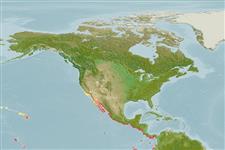Environment: milieu / climate zone / depth range / distribution range
Ökologie
seewasser; süßwasser; brackwasser demersal; pH range: 7.5 - 9.5; amphidrom (Ref. 51243); tiefenbereich 1 - ? m. Subtropical; 25°C - 33°C (Ref. 36880); 41°N - 0°S
Eastern Pacific: Palos Verdes in southern California, USA to Peru.
Length at first maturity / Size / Gewicht / Alter
Maturity: Lm ?, range 17 - ? cm
Max length : 41.0 cm TL Männchen/unbestimmt; (Ref. 5404); 39.0 cm TL (female); common length : 25.0 cm TL Männchen/unbestimmt; (Ref. 55763); max. veröff. Gewicht: 1.2 kg (Ref. 5404); max. veröff. Gewicht: 1.2 kg
Body compressed; head flat; first dorsal fin with 7 spines, second with 1 spine and 8 to 9 rays; anal fin with 1 spine and 9 to 10 rays; lateral line with 30 to 34 scales; body depth contained about three times in standard length; body dark green to dark brown with numerous small pale spots (Ref. 55763).
Facultative air-breathing (Ref. 126274); Inhabit estuaries, stagnant ditches or creeks of low current velocity between the sea and an elevation of 30 m. Benthic and most abundant on sandy and muddy bottoms. Ingests much mud and detritus, although also filter plankton (Ref. 36880). Found in shallow inshore areas; typically in freshwater but moves freely into the sea.
Eschmeyer, W.N., E.S. Herald and H. Hammann, 1983. A field guide to Pacific coast fishes of North America. Boston (MA, USA): Houghton Mifflin Company. xii+336 p. (Ref. 2850)
IUCN Rote Liste Status (Ref. 130435)
Bedrohung für Menschen
Harmless
Nutzung durch Menschen
Warning: mysqli::__construct(): (HY000/1040): Too many connections in /var/www/html/includes/func_getlabel.php on line 46
Can't connect to MySQL database (fbapp). Errorcode: Too many connections
